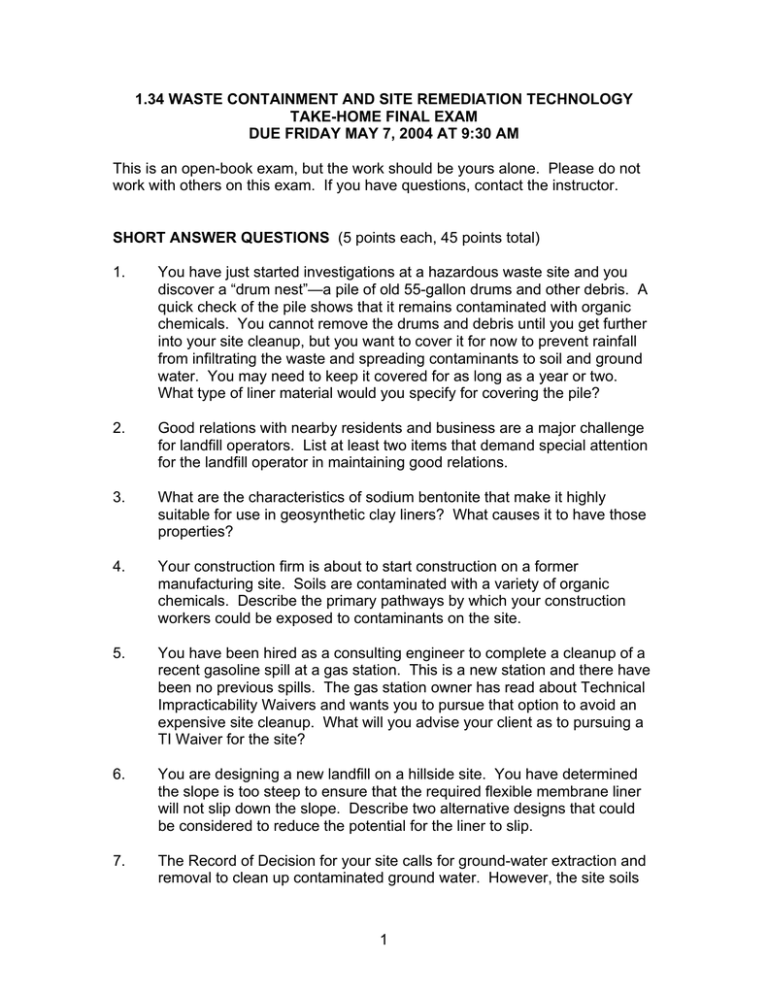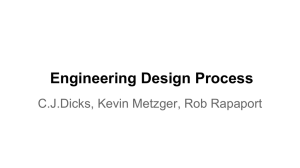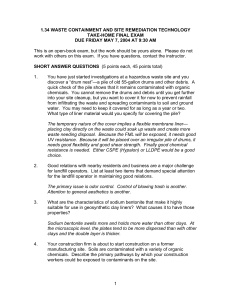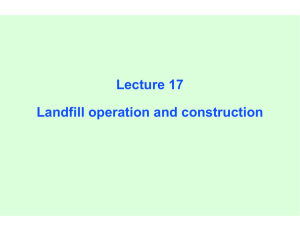1.34 WASTE CONTAINMENT AND SITE REMEDIATION TECHNOLOGY TAKE-HOME FINAL EXAM
advertisement

1.34 WASTE CONTAINMENT AND SITE REMEDIATION TECHNOLOGY TAKE-HOME FINAL EXAM DUE FRIDAY MAY 7, 2004 AT 9:30 AM This is an open-book exam, but the work should be yours alone. Please do not work with others on this exam. If you have questions, contact the instructor. SHORT ANSWER QUESTIONS (5 points each, 45 points total) 1. You have just started investigations at a hazardous waste site and you discover a “drum nest”—a pile of old 55-gallon drums and other debris. A quick check of the pile shows that it remains contaminated with organic chemicals. You cannot remove the drums and debris until you get further into your site cleanup, but you want to cover it for now to prevent rainfall from infiltrating the waste and spreading contaminants to soil and ground water. You may need to keep it covered for as long as a year or two. What type of liner material would you specify for covering the pile? 2. Good relations with nearby residents and business are a major challenge for landfill operators. List at least two items that demand special attention for the landfill operator in maintaining good relations. 3. What are the characteristics of sodium bentonite that make it highly suitable for use in geosynthetic clay liners? What causes it to have those properties? 4. Your construction firm is about to start construction on a former manufacturing site. Soils are contaminated with a variety of organic chemicals. Describe the primary pathways by which your construction workers could be exposed to contaminants on the site. 5. You have been hired as a consulting engineer to complete a cleanup of a recent gasoline spill at a gas station. This is a new station and there have been no previous spills. The gas station owner has read about Technical Impracticability Waivers and wants you to pursue that option to avoid an expensive site cleanup. What will you advise your client as to pursuing a TI Waiver for the site? 6. You are designing a new landfill on a hillside site. You have determined the slope is too steep to ensure that the required flexible membrane liner will not slip down the slope. Describe two alternative designs that could be considered to reduce the potential for the liner to slip. 7. The Record of Decision for your site calls for ground-water extraction and removal to clean up contaminated ground water. However, the site soils 1 are silt and yield only small amounts of water to conventional wells. Suggest a technology that meets the ROD requirement for ground-water extraction under these site conditions. 8. You have just completed a site screening analysis for a new hazardous waste disposal site. You have used multiple criteria to identify favorable sites in New England, and come up with a few sites, one of which is very favorable. On further investigation, you have found that this very favorable site violates one your original screening criteria, which is that there should be no usable aquifer under your site. Your investigations have shown that there is an aquifer beneath your site, but that it is separated from the land surface by a thick layer of marine clay with very low hydraulic conductivity. Should you now eliminate this site since it violates your original screening criterion? Why or why not? 9. You run a business buying the rights to methane gas from municipal solid waste landfills and selling it to nearby power generators. The town of Mitville closed their municipal landfill 20 years ago but recently learned of the potential value in their old landfill. They have approached you to buy the gas rights to their landfill. Would this arrangement by beneficial to both you and the town? 2 QUANTITATIVE AND CONCEPTUAL QUESTIONS (55 points total) 10. (20 points) A void was left below a patch on the flexible membrane liner at a hazardous waste disposal landfill as shown in the sketch below. The void contains both air and water. Leachate with a concentration of CL of toluene lies atop the overlying liner. The liner is overlain by a drainage layer, geotextile, and waste material in that order from bottom to top. Leachate with concentration CL Air bubble in void Liner patch Water in void with concentration CW Leachate with concentration CL Flexible membrane liner Please complete the following: a. Describe qualitatively how the concentration in the void will change over time assuming the enclosed water and air are initially free of toluene. b. Construct an equation for the steady-state concentration of toluene in the water within the liner void, CW, as a function of the concentration in the leachate, CL. c. Construct an equation for the steady-state concentration in the air bubble within the void as a function of the concentration in the leachate, CL. 3 11. (20 points) Evapotranspiration landfill covers have been proposed for landfill caps in arid areas. The concept is to rely upon natural evapotranspiration rather than an impervious capping material to keep water out of the waste. In the monolithic ET cap design, a relatively thick layer of silt or clayey silt is the only cover material. This soil layer is planted with natural vegetation. a. Describe qualitatively how the annual Thornthwaite water balance for an ET landfill cover in an arid area would differ from the water balance for a conventional landfill cover in a climate like Boston’s. b. In terms of the Thornthwaite water balance, give two specific design criteria necessary for a successful ET cover. 12. (15 points) You are constructing a new landfill liner and have just finished laying down a geosynthetic clay liner (GCL). The liner is on a side slope of the landfill that is 10 meters high with a slope of 3:1. At the top of the slope, the liner has been very securely anchored by an anchor trench. The GCL material has a yield stress of 100 kPa. The GCL is 0.5 cm thick and has a mass per unit area of 3600 gm/m2. The friction angle between the GCL and the underlying soil has been found to be 25°. Your construction site has been visited at night by vehicles “off-roading” on the landfill slope. Assume a 2-meter wide vehicle weighing 1.5 metric tons parks on the GCL. Will the liner fail under this static load? 4









